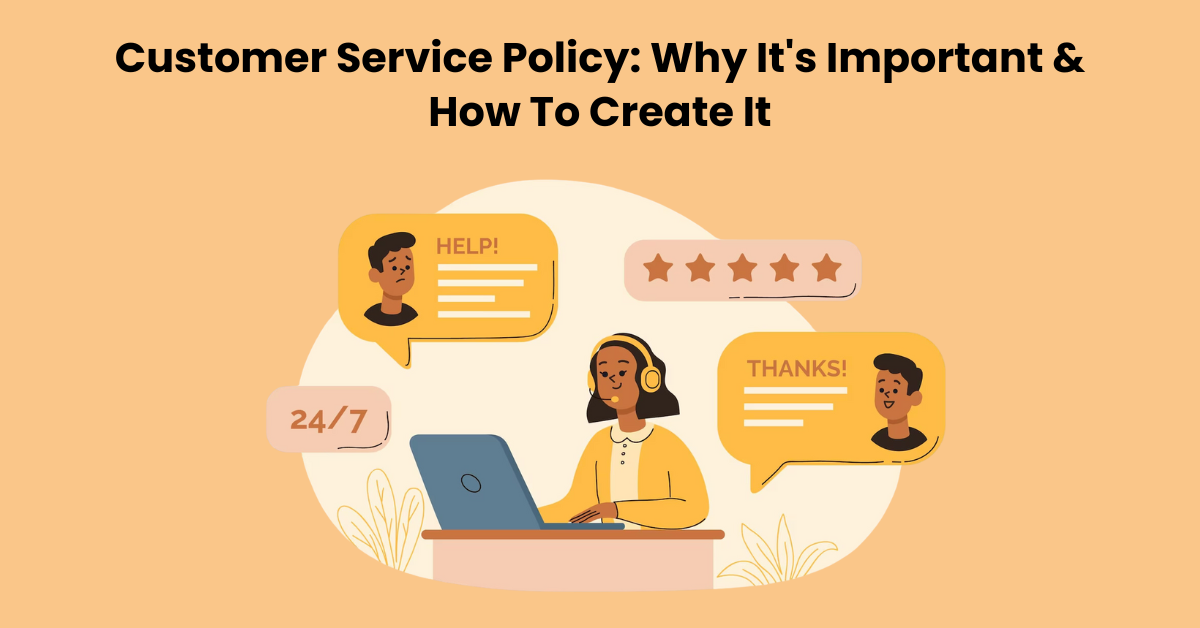Customer Service Policy: Why It's Important & How To Create It

Providing outstanding customer service is no longer just an option in today's corporate environment—it has become crucial. A vital, if occasionally underappreciated, instrument is required to guarantee that your staff continuously provides experiences that allow consumers to feel valued and understood: the customer service policy. This blog post explores the importance of having well-defined customer service policies. It looks at how it can empower your team, foster client loyalty, and ultimately help your business succeed. Furthermore, we will guide you through drafting a successful policy, providing helpful advice and a useful list of customer service policies and procedures to enable you to create a document that elevates your customer service to a new level.
Customer Service Policy: Overview

A customer service policy is a fundamental document that describes the guidelines and practices that direct how a business interacts with its clients. It sets guidelines for providing outstanding customer service, responding to questions and grievances from clients, and guaranteeing uniform experiences at every point of contact. In addition to outlining the business's dedication to customer satisfaction, this policy acts as a manual for staff members, helping them to comprehend their roles and responsibilities in delivering exceptional customer service. Clearly defined customer service initiatives help to develop trust, increase loyalty, and eventually improve the overall customer experience, all of which contribute to the business's success and reputation. It does this by clearly defining expectations and procedures.
Types of Customer Service Policy

Best customer service policies are a document that outlines the guidelines and procedures that employees should follow when interacting with customers. It serves as a roadmap for delivering consistent, high-quality service across all channels.
There are different types of customer service policies, each focusing on specific aspects of the customer experience. Here are some of the most common types of customer service policy:
Return and Refund Policy: This policy outlines the conditions under which customers can return or exchange products, as well as the process for receiving refunds.
Response Time Policy: This policy defines the expected timeframe for responding to customer inquiries or complaints through various channels, such as email, phone, or chat.
Communication Policy: This policy establishes guidelines for how employees should communicate with customers, including the tone and language used, as well as the preferred communication channels.
Escalation Policy: This policy outlines the process for escalating unresolved customer issues to higher levels of management.
Privacy Policy: This policy explains how a company collects, uses, and protects customer data.
Payment Policy: This policy outlines the accepted payment methods and any associated fees or limitations.
Warranty Policy: This policy explains the terms and conditions of a product's warranty, including coverage duration, repair or replacement procedures, and exclusions.
How To Create a Customer Service Policy?
Here's a step-by-step guide on how to create a customer service policy for your business:
Define Your Objectives: Clearly outline the objectives of your customer service policy. What do you want to achieve through your customer service efforts? Examples include enhancing customer satisfaction, resolving issues promptly, and maintaining a positive brand image.
Understand Your Customer Base: Identify your target audience and understand their needs and expectations. Tailor your customer service policy to address the specific requirements and preferences of your customers.
Establish Core Values: Define the core values that will guide your customer service interactions. These values should align with your overall business values and contribute to a positive customer experience.
Determine Communication Channels: Specify the communication channels through which customers can reach your support team (e.g., phone, email, chat, social media). Communicate the availability and response times for each channel.
Create Response Time Standards: Set clear standards for response times to customer inquiries, complaints, and feedback. Define realistic timeframes and ensure that your team adheres to these standards consistently.
Develop Issue Resolution Procedures: Outline a step-by-step process for handling customer issues and complaints. Include escalation procedures for more complex problems, ensuring timely resolution at each level.
Formulate Refund and Return Policies: Clearly define the conditions under which customers are eligible for refunds and returns. Specify any associated costs, timeframes, and necessary documentation.
Implement Privacy and Data Security Measures: Establish protocols for safeguarding customer data. Ensure compliance with data protection laws and communicate how customer information is collected, used, and protected.
Encourage Customer Feedback: Develop a system for collecting customer feedback. Encourage customers to share their experiences and use this information to make continuous improvements to your products, services, and customer service processes.
Train Your Customer Service Team: Provide comprehensive training to your customer service representatives. Ensure they understand the customer service policy, core values, and effective communication strategies.
Regularly Review and Update: Customer needs and industry standards evolve. Regularly review and update your customer service guidelines & policy to ensure it remain relevant and aligned with current expectations.
Communicate Your Policy to Customers: Communicate your customer service policy to customers through your website, marketing materials, and customer interactions. Make it easily accessible and understandable.
Seek Legal Guidance: Ensure that your customer service policy complies with local and international laws. Seek legal guidance to address any regulatory requirements.
Monitor and Evaluate Performance: Implement systems for monitoring and evaluating the performance of your customer service team. Use customer service key performance indicators (KPIs) to assess the effectiveness of your policy.
Seek Customer Input: Actively seek input from customers on your customer service policies. This can help identify areas for improvement and demonstrate your commitment to customer satisfaction.
Customer Service Policy: Importance
Here's how a strong policy benefits your business:
Empowers Employees
Clear guidelines: The customer service policy equips employees with a roadmap for handling customer interactions, fostering confidence and consistency in their approach.
Improved decision-making: The customer service policy empowers them to make informed decisions regarding common customer inquiries and issues, reducing the need for constant supervision and escalation.
Increased motivation: A clear understanding of expectations and company values can boost employee morale and motivation to deliver exceptional service.
Fosters Customer Loyalty
Consistent experiences: The policy ensures customers receive consistent, high-quality service regardless of the employee or communication channel they use.
Increased satisfaction: Consistent positive interactions lead to higher customer satisfaction, building trust and loyalty towards your brand.
Reduced customer churn: Satisfied customers are more likely to remain loyal, reducing customer churn and increasing customer lifetime value.
Drives Business Success
Positive brand image: A reputation for excellent customer service fosters positive word-of-mouth marketing, attracting new customers and enhancing brand reputation.
Improved sales and revenue: Loyal customers are more likely to return for repeat business and recommend your products or services to others, increasing sales and revenue.
Enhanced efficiency: Clear policies streamline customer service processes, reducing operational costs and improving efficiency within your organization.
Customer Service Policy: Templates
Here are three essential customer service policy examples or templates that cover different aspects of customer service:
General Customer Service Policy
Objective: To deliver exceptional customer service and ensure customer satisfaction.
Key Points
Commitment to Customer Needs: We are committed to understanding and meeting our customers' needs promptly and effectively.
Timely Response: All customer inquiries, concerns, and feedback will be responded to within [specific timeframe].
Professional Communication: Our communication with customers will always be courteous, professional, and aligned with our brand values.
Issue Resolution: We will strive to resolve customer issues fairly and efficiently, ensuring a positive resolution for all parties involved.
Communication Policy
Objective: To maintain clear and effective communication with customers.
Key Points
Timely Responses: Customer inquiries will be acknowledged within [specific timeframe], and updates will be provided regularly.
Professional Language: All communication will use polite and professional language, fostering a positive and respectful interaction.
Information Transparency: Customers will be kept informed about the status of their requests and provided with clear and concise information.
Refund and Return Policy
Objective: To provide clear guidelines for product returns and refunds.
Key Points
Eligibility Criteria: State conditions for eligible returns and refunds, including timeframes and product conditions.
Return Process: Provide step-by-step information on the return process, including any necessary forms or documentation.
Costs and Fees: Specify any restocking fees or return shipping costs that may apply.
Legal Compliance: Ensure full compliance with local and international consumer protection laws regarding refunds and returns.
How do you improve your customer service using Manifest AI?

Boosting customer service in the current digital environment can be significantly improved by integrating AI technology. Manifest AI provides a range of tools specifically aimed at enhancing the quality of customer support. Here's how these tools can be utilized effectively:
AI Support: Start with adding AI Support to your customer service operations. This functionality enables automatic responses to frequently asked questions, offering quick help without needing live personnel. This ensures that customers get prompt and correct responses, boosting their satisfaction and the efficiency of the service.
AI Nudge: Use AI Nudge to actively connect with customers through their online behavior and past interactions. This tool can recommend suitable products, remind customers about items they've considered in the past, or extend personalized offers, motivating them to finalize their purchases and improve their experience.
AI Search: Improve your site's search capability with AI Search. This feature lets customers find what they need using conversational language, streamlining the search process. By simplifying how customers locate products, you minimize frustration and elevate the shopping experience.
AI Quiz: Employ AI Quiz to collect data on customer preferences and requirements via interactive quizzes. This data can then inform personalized product suggestions, helping customers feel seen and appreciated. This is a deliberate method to boost involvement and customize the shopping journey for each user.
Conclusion
To sum up, developing a clear customer service policy is an investment in your company's future. Giving your staff clear direction and encouraging a culture of great customer service can empower them, win over customers, and eventually lead to commercial success. Keep in mind that a customer service policy is a living document, so make sure it stays current with your changing business demands and the dynamic client base by giving it regular reviews and revisions. By doing this, you can make sure that in a crowded market, your customer service continues to be a source of competitive advantage and a crucial differentiator.

.png)
